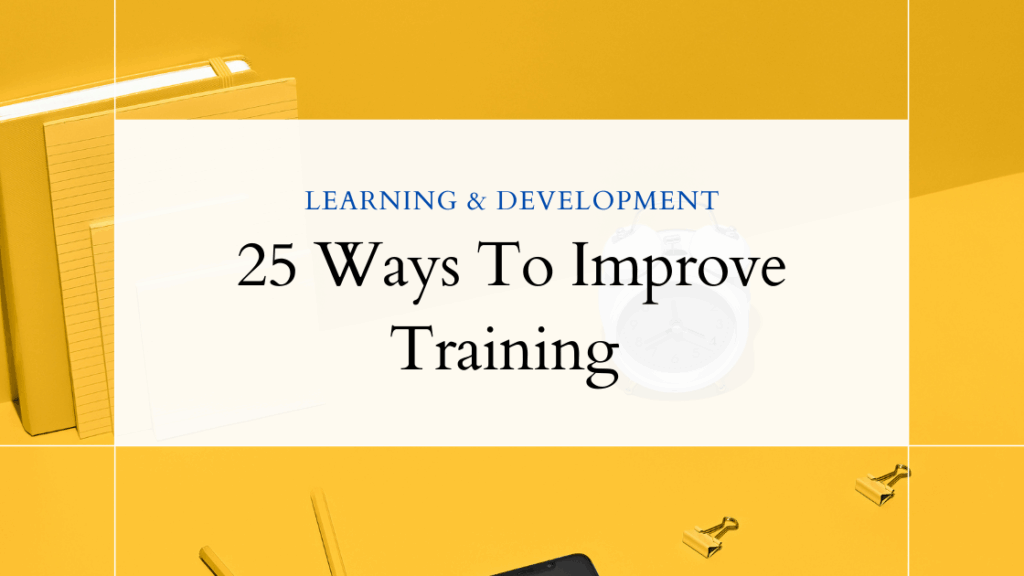
Improving our work can feel overwhelming. Where do you even begin? Here’s a list of 25 ways you can improve your work. Start with one. Do what works for you, skip what doesn’t.
Let me know what you try or what you’d add to the list!
Designing Learning
- Design training that gets people involved in performing what you want them to do on the job. Interpersonal skills? Talk in small groups. Leadership? Role play. This is the Application (practice) piece of PAFR3 many of you’ve learned with me.
- Do less for the learner. Yes, I said it. Do less. Let them do more. Look at your training design. Are you talking too much? (See #8) Are you over explaining? Try less. Get them doing more. (see #1).
- Embrace effort. Learning is effortful. In a world filled with shortcuts and hacks, it still requires EFFORT for people to learn. Your job isn’t to make learning easier. Your job is to make it more accessible and supported.
Connection and Context
- Build connection before content. Consider your training like a dinner party. Invite guests in, greet them, introduce them quickly to each other. Engagement increases when everyone feels more comfortable with the people they are sharing space with.
- Provide context. We all need context to learn new concepts. Build context for your topic. Ask “what do you already know about…” or “who has experience with…”
- Start with a pause. Take a moment before you dive into a topic to find out what people want. Come back to it throughout your program to check their progress.
- Acknowledge what’s in the room. Compliance training with reluctant participants? Acknowledge it. Say, “I know you have other places to be.” Ask, “how many times have you been through this?” The room’s climate will change for the better.
- Embrace the power of 10. Don’t talk longer than 10 minutes. Change things up every 10 minutes. Work in 10s. See how engagement changes.
- Make your instructions visual. If you are providing activity instructions verbally, consider making them visual. People will appreciate that they can look somewhere to remind themselves what they need to do.
Make Breakout Rooms Work
- Be intentional with virtual breakout rooms. Stick with small group sizes (3-5 people). Assign a facilitator (see #12). Give clear, precise directions for what they are supposed to do (see #9).
- Share your screen to the breakout room. It helps keep groups on task and avoid that awkward moment where everyone looks at each other and wonders what they are supposed to do.
- Assign facilitators for group work. Use a fun method like, “the person wearing the most colorful socks” or “whoever last ate a green vegetable.” You can go with more obvious things as well like the person with the shortest hair. Consider putting instructions for picking a facilitator on a slide shared to the breakout room (see #9).
- Tell them what you want. Are you going to ask groups to share out? Let them know when they go in the room. Set the expectation. Call on the facilitators room by room. You’ll save time and avoid those awkward moments when everyone wonders who is going to speak. (Remind them on a slide shared to the breakout room! see #11)
- Fail to learn. We learn when we get things wrong. Encourage and create opportunities for failure in training. And share your own! People will appreciate it (and you).
- Get them moving! Whether virtual or in person, we need movement to learn. Change things up. Stand up. Include short walks. Always add the words, “if it’s available to you” when asking people to move or stand.
Pause!
- Take a strategic pause. Build strategic moments for reflection throughout a learning experience. Take 2 minutes and ask everyone to write down what they can recall and 2 minutes to write down what they will do with what they recall. (And stay tuned for my October 2025 ATD Press book launch — I know the official title now!)
- Take a break! Breaks are essential for learning. Overload people and you are wasting everyone’s time. Everyone’s cognitive load is a bit different. Less is usually more for everyone.
Ask Good Questions
- Ask good questions. Questions enhance engagement and learning. Try to ask open-ended questions that require more than a yes or no answer. Give people time to respond.
- “Stay curious a little longer,” from the incomparable Michael Bungay-Steiner. For trainers and facilitators that means, ask more questions. Wait for responses. And perhaps, ask questions you don’t know the answers to yourself!
- Ask “what are you wondering?” Give up asking if there are any questions, go for wonders instead. People are more willing to share what they are wondering. It embraces curiosity. You’ll be so pleased with the responses. You can read more about my WonderWall here.
- Follow up on wonders. After you’ve asked about wonders, consider putting people in groups to discuss wonders or following up with a wonder list for people to review.
- Follow up. Research by Actionable.com has shown when facilitators follow up with learners after a session they are more likely to use the behaviors you trained. Even more impactful than managers!
- Show the impact. Before training identify what you want to change in the workplace. After training, see if that change occurred.
- Take notes. During a training keep notes of what’s working and what’s not. You’ll create a valuable tool to use for redesigning your next training.
- Enjoy. Enjoy what you do. You are amazing and you impact people in your organization in powerful ways.

[…] If the pause isn’t working for you, here are a few more ideas to prod your learners to respond. […]